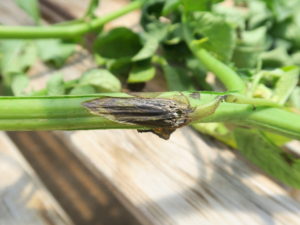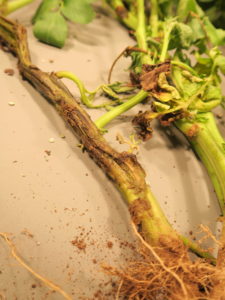This disease has been observed in southern Indiana. Symptoms often begin with dark, wet-looking lesions on the stem (Figure 1). These lesions may extend up the stem and result in the wilt and death of the plant (Figure 2). Occasionally, opportunistic microorganisms invade the stem and produce a disagreeable rotten odor.
The conditions that may favor aerial blackleg include dense canopies and warm, wet weather. Overhead irrigation can also be a factor in promoting aerial blackleg.
The bacteria which cause aerial blackleg are Dickeya and Pectobacterium spp. These bacteria are often introduced by infected seed potatoes. The bacteria may then spread into the soil and be splashed into wounds or leaf scars. Conversely, the bacteria have been reported to survive 2 years or less in crop debris.
It is important to note that while symptoms of aerial blackleg do not include rot of the seed piece, blackleg may start on the seed piece and travel up the plant. Therefore, examine the seed piece to see where the blackleg symptoms started.
Since the most common method of introducing the bacterium into the field is through potato seed pieces, it is important to consider seed source. Use seed from potato certification programs. Clean and sanitize seed storage facilities. Be careful not to spread the bacteria during cutting operations. Take care to harvest potatoes in good condition.
To minimize aerial blackleg, avoid excessive irrigation and nitrogen fertilization. Products with the active ingredient copper may slow the progress of areal blackleg.

